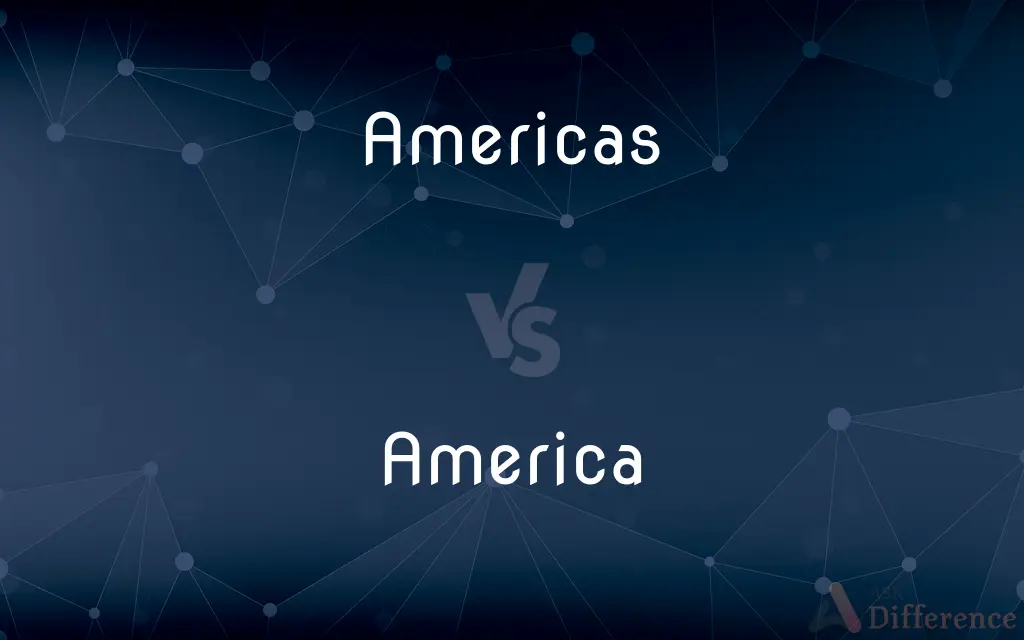Americas vs. America — What's the Difference?
By Urooj Arif & Maham Liaqat — Updated on April 18, 2024
"Americas" refers to the combined continents of North and South America, including associated islands, while "America" often informally refers to the United States.

Difference Between Americas and America
Table of Contents
ADVERTISEMENT
Key Differences
The term "Americas" encompasses both the North American and South American continents, along with Central America and the Caribbean islands. It highlights the geographic, cultural, and political diversity spanning from the Arctic Circle to the southern tip of Tierra del Fuego. On the other hand, "America" is commonly used as a shorthand for the United States of America, emphasizing its role as a single sovereign nation.
The Americas are characterized by a wide range of environments, from the tundras of northern Canada to the rainforests of the Amazon. Whereas, when referring to "America," people often focus on the cultural and political identity of the United States, which includes its global influence and internal diversity.
In international contexts, the term "Americas" is used to differentiate discussions that involve multiple countries across the North and South American continents. In contrast, "America" in such settings is typically understood to mean the United States, reflecting its significant presence on the international stage.
The use of "Americas" promotes a more inclusive understanding of the two continents, acknowledging the presence of 35 countries with distinct languages, cultures, and histories. On the other hand, the use of "America" to refer to the United States can sometimes lead to confusion or cultural oversight, especially in discussions involving international participants.
Education systems and international organizations often use "Americas" to refer to cooperative efforts across countries, such as economic partnerships or environmental agreements. Whereas "America" might be used to describe policies or cultural phenomena specifically pertaining to the United States.
ADVERTISEMENT
Comparison Chart
Geographic Scope
North and South America, plus associated regions
Primarily refers to the United States
Number of Countries
Includes 35 countries
Refers to one country
Cultural Diversity
Encompasses diverse cultures spanning two continents
Often associated with U.S. cultural identity
Political Entities
Multiple sovereign states and territories
A single sovereign state
Common Usage
Used in discussions involving multiple countries
Often used domestically and internationally to refer to the U.S.
Compare with Definitions
Americas
Used to describe initiatives or issues affecting both continents.
The Americas face significant challenges in terms of climate change and biodiversity conservation.
America
Refers to U.S. governmental or political actions.
America's foreign policy decisions have far-reaching effects around the globe.
Americas
A term used in international relations to refer to cooperation between countries across two continents.
Trade agreements in the Americas often involve multiple countries working together.
America
Informally, the term used domestically and internationally to refer to the United States.
America has a significant influence on global economic policies.
Americas
A geographical term referring to all territories in North and South America.
The cultural diversity of the Americas is vast, ranging from indigenous communities to global cities.
America
The setting for various social and economic discussions or policies.
America's healthcare system is often debated in political contexts.
Americas
The collective landmass of North and South America.
The Andes mountains are among the longest mountain ranges in the Americas.
America
A national identity that encompasses the United States' history and culture.
America is known worldwide for its cultural exports like movies and music.
Americas
Pertaining to the broad expanse from the northern reaches of Canada to the southern tip of Chile.
Bird species in the Americas vary dramatically from the Arctic to the equatorial regions.
America
Associated with the ideals of democracy and freedom as represented by the U.S.
The Statue of Liberty is a symbol of America's commitment to freedom.
Americas
The Americas, which are also collectively called America, are a landmass comprising the totality of North and South America. The Americas make up most of the land in Earth's Western Hemisphere and comprise the New World.Along with their associated islands, the Americas cover 8% of Earth's total surface area and 28.4% of its land area.
America
48 conterminous states in North America plus Alaska in northwest North America and the Hawaiian Islands in the Pacific Ocean; achieved independence in 1776
America
North and South America
Common Curiosities
What is meant by the Americas?
The Americas refer to the combined continents of North and South America, including all countries and islands within these regions.
How does the use of America to refer to the U.S. affect perceptions?
Using "America" to refer to the U.S. can sometimes lead to misunderstandings or perceptions of cultural insensitivity, particularly in international settings where the broader Americas are discussed.
Why do people refer to the United States as America?
The term "America" is commonly used as a shorthand for the United States of America, due to historical usage and its prominence.
Are the terms Americas and America interchangeable?
No, the Americas refers to two continents and multiple countries, while America often specifically refers to the United States.
Is it correct to use America when discussing international relations?
In international contexts, it's more precise to use "United States" to avoid confusion with the broader Americas.
What regions are included in the Americas?
The Americas include North America, Central America, South America, and the Caribbean islands.
What is the political significance of America in global affairs?
As a superpower, the United States (America) plays a crucial role in global affairs, influencing international policies and economies.
Can America be considered a continent?
No, America is not a continent but a common colloquial term for the United States. The continents are North America and South America.
How do educational systems differ across the Americas?
Educational systems in the Americas vary widely, with each country having its own approach to education, influenced by its specific cultural and historical context.
Why is America often used synonymously with the United States in popular media?
This usage likely stems from historical contexts where the United States was a dominant cultural and political force, influencing media and language use globally.
What cultural diversity exists within the Americas?
The Americas are home to a wide range of cultural identities, including indigenous peoples, descendants of European colonists, African diaspora communities, and recent immigrants from around the world.
How does the geographical scope of America compare to that of the Americas?
"America" usually refers to the U.S., a single country, while the "Americas" encompass an entire region including two continents and numerous countries.
What are common misconceptions about America and the Americas?
A common misconception is that "America" and "the United States" are synonymous with the entire Western Hemisphere, which overlooks the diverse countries and cultures present throughout the Americas.
What impact does American culture have on the Americas?
American culture, particularly from the United States, has significant influence across the Americas in terms of media, fashion, technology, and business practices.
How do international agreements involve the Americas?
International agreements involving the Americas often address issues like trade, environmental protection, and human rights, requiring cooperation across multiple countries in the region.
Share Your Discovery

Previous Comparison
Fragile vs. Vulnerability
Next Comparison
Shove vs. ShovelAuthor Spotlight
Written by
Urooj ArifUrooj is a skilled content writer at Ask Difference, known for her exceptional ability to simplify complex topics into engaging and informative content. With a passion for research and a flair for clear, concise writing, she consistently delivers articles that resonate with our diverse audience.
Co-written by
Maham Liaqat













































